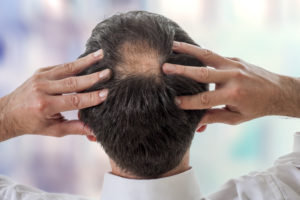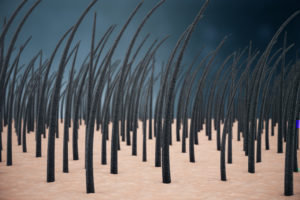Finasteride – are the risks worth it?
Short facts about hair loss and finasteride
- Hair plays a vital part in the appearance of both men and women and helps to transmit sensory information.
- An adult has about 100,000 to 150,000 hairs and loses up to 100 hairs a day.
- The scalp hair grows approximately 0.35 mm per day.
- Hair is composed of 2 different structures: the hair follicle which resides in the skin, and second, the shaft, which is visible above the scalp.
- Hair growth has 3 stages of growth and shedding: anagen phase, the catagen phase and telogen phase.
- During intrauterine life, approximately 5 million hair follicles are developed on the body.
- By week 22, a developing foetus has all its hair follicles formed.
- No follicles are formed after birth.
- Androgenetic alopecia is commonly called male or female pattern baldness.
- The hair follicles affected by androgenetic alopecia are permanently damaged and any hair loss, as a result, is irreversible.
- Dihydrotestosterone (DHT) is the main hormone responsible for androgenetic alopecia.
- DHT causes scalp hair loss by inducing a change in the hair follicles on the scalp.
- Finasteride belongs to type II ‘5-alpha-reductase inhibitors.
- Finasteride has no effect in women hair loss.
- The rate of hair growth slows with age.
- The hair loss risk factors include a family history of balding, age, significant weight loss, certain medical conditions, such as diabetes and lupus, and stress.

Hair growth phases
The hair has 3 stages of growth and shedding:
- Anagen phase;
- Catagen phase;
- Telogen phase.
Anagen phase
Anagen phase represents the active phase of hair growth and it lasts about 3 to 5 years.
The following transformations occur during this phase:
- The cells in the root of the hair are dividing rapidly. The hair follicle begins to enlarge and grow into the scalp.
- A hair bulb is formed at the very bottom of the hair follicle.
- Connective structures called dermal papillae attach to the very bulb of the hair follicle and provide nourishment so that the hair may grow.
- The hair shaft begins to grow upward and outward from the scalp. If an old hair is still present, the new hair shaft pushes it up and out of the follicle.
During this phase, the hair grows about 1 cm every 28 days. At any one time, approximately 85 to 90% of scalp follicles are in the anagen phase of hair growth.
Body hair has the same mechanism of growth with the scalp hair. However, body hair remains in the active phase for a short period (about 30 to 45 days). This is why body hair grows remarkably shorter than the hair on the scalp.
Genetics may influence the anagen phase. Some people have difficulty growing their hair beyond a certain length because they have a short active phase of growth. On the other hand, people with very long hair have a long active phase of growth. For example, the Asian people typically have hair that stays in this growth phase for a longer duration than other ethnicities. Genetic disorders can determinate the body hair to remain in an active state of growth for as long as the hair on the scalp. In other rare cases, scalp hair remains in the phase for as long as body hair, resulting in hair that does not grow more than a few inches long. The length of the anagen phase can also be influenced by external factors such as environmental toxins and extreme stress.
Catagen
The catagen phase represents the second part of a hair’s lifecycle and it is a transitional stage. This phase lasts for about 2 to 3 weeks. Growth stops, and the outer root sheath shrinks and attaches to the root of the hair. Once the hair bulb no longer has access to the blood supply, it begins to convert to keratin. During this keratinisation process, the hair bulb becomes shaped like a club.
Telogen
Telogen phase is the third phase of the hair’s cycle, occurring after both the anagen phase and catagen phase. During this phase, the hair growth is ceased, and the hair becomes fully keratinised. The dermal papilla enters a resting state and does not supply any nutrition to the hair, which is fully grown. Telogen is the resting phase and usually accounts for 6% to 8% of all hairs. This phase lasts for about 100 days for hairs on the scalp and longer for hairs on the eyebrow, eyelash, arm, and leg. During this phase, the hair follicle is completely at rest and the club hair is completely formed. Each day are shed about 25 to 100 telogen hairs. At the end of the telogen phase, the original hair falls out (exogenous phase) and is replaced by a new hair at the early growth stage.
What are the most common risk factors for hair loss?
Hair loss, also known as alopecia has a significant effect on the social and psychologic well-being of both men and women of all ages.
Etymologically, the word “alopecia” comes from the Greek ἀλώπηξ (alōpēx), which means “fox”. It is an allusion to the constant hair loss suffered by these animals during life.
One or more of the following factors may lead to the occurrence of hair loss:
- Family history (heredity)
- Hormones, such as abnormal levels of androgens;
- Stress;
- Illness;
- Childbirth;
- Drugs, including chemotherapy drugs used in cancer treatment, blood thinners, beta-adrenergic blockers used to control blood pressure, and birth control pills;
- Burns, injuries, and X-rays;
- Autoimmune diseases;
- Cosmetic procedures, such as shampooing too often, perms, bleaching, dyeing hair, tight braiding, using rollers or hot curlers
- Medical conditions like thyroid disease, lupus, diabetes, iron deficiency anaemia, eating disorders;
- Low-protein diet or severely calorie-restricted diet.
Can hair loss be cured? Which is the available treatment?
Pharmacological treatment of hair loss
The most commonly used drugs for hair loss are:
- Minoxidil (Rogaine): it is a topical solution that is applied to the scalp to stimulate hair follicles. It comes in 2% and 5% solutions and is applied once daily.
- Finasteride (Propecia, Proscar): it is a pill that interferes with the production of a form of testosterone that is linked to baldness. This drug is not indicated to be used in females. Women who are or may become pregnant should not handle crushed or broken finasteride tablets when they are pregnant or may potentially be pregnant because of the possibility of absorption of finasteride and the subsequent potential risk to a male foetus.
Non- pharmacological treatment of hair loss
Hair transplantation: involves harvesting follicles from the back of the head that are DHT resistant and transplanting them to bald areas.
Low-level laser therapy: a form of light and heat treatment. Low-level laser therapy has been shown to stimulate hair growth in both men and women. Researchers hypothesize that the main mechanisms involved in the process is the stimulation of epidermal stem cells in the follicle and shifting the follicle back into the growth phase of the cycle.
What is finasteride and how does it work?
Finasteride is a prescription drug available as oral tablets. Finasteride can be found under the brand names Proscar (5 mg tablets) and Propecia (1 mg tablets).
Finasteride belongs to the class of drugs called 5 alpha-reductase inhibitors. The 5 alpha-reductase is an intracellular enzyme that converts testosterone to its active form, DHT.
DHT is the main hormone responsible for androgenetic alopecia. This hormone leads to the occurrence of scalp hair loss by inducing a change in the hair follicles on the scalp. Also, dihydrotestosterone leads to prostate enlargement.
Finasteride formulated as 1 mg tablets are indicated in the treatment of androgenic alopecia (men only), while finasteride 5 mg tablets are used in the treatment of benign prostatic hyperplasia.
Finasteride is a competitive and specific inhibitor of type II 5 alpha-reductase. Hair follicles contain type II 5α-reductase. In men with male pattern hair loss, the balding scalp contains miniaturised hair follicles and increased amounts of DHT. Administration of finasteride decreases scalp and serum DHT concentrations in these men. Men with a genetic deficiency of type II 5 alpha-reductase do not suffer from male pattern hair loss. Finasteride inhibits a process responsible for miniaturisation of the scalp hair follicles, which can lead to the reversal of the balding process.
Pharmacokinetic profile of finasteride
Absorption
Compared with an intravenous interference dose, oral bioavailability of finasteride is approximately 80%. Oral bioavailability is not influenced by food. Maximum plasma concentration of finasteride is reached approximately 2 hours after administration and the absorption is complete after 6 to 8 hours.
Distribution
Finasteride binds the proteins in proportion of approximately 93%. Its volume of distribution is approximately 76 litres. Finasteride has been recovered in the cerebrospinal fluid (CSF), but the drug does not appear to concentrate preferentially to the CSF. A small amount of finasteride has also been detected in the seminal fluid of subjects receiving the drug.
Biotransformation
Finasteride is metabolized via cytochrome P450 3A4 system to 2 metabolites. The metabolites were found to possess only a small fraction of the 5-alpha-reductase inhibitory activity of finasteride.
Elimination
Following an oral dose of finasteride, 39% of the dose was excreted in the urine in the form of metabolites and 57% of the total dose was excreted in the faeces.
Plasma clearance is approximately 165 ml/min.
The elimination rate of finasteride decreases somewhat with age. Mean terminal half-life is approximately 5-6 hours in men 18-60 years of age and 8 hours in men more than 70 years of age. These findings are of no clinical significance and hence, a reduction in dosage in the elderly is not warranted.

Is finasteride safe? What are the side effects?
Like all medicines, this medicine can cause side effects, although not everybody gets them. Some of the side effects are temporary with continued treatment or disappear when treatment is stopped.
Stop taking finasteride and immediately contact a doctor if you have any of the following experience:
- Symptoms of an allergic reaction: swelling of your lips, face, tongue and throat; difficulty swallowing; lumps under your skin (hives) and breathing difficulties;
- Depression (feelings of severe sadness and unworthiness).
You should promptly report to your doctor any changes in the breast tissue such as lumps, pain, enlargement of the breast tissue or nipple discharge as these may be signs of a serious condition, such as breast cancer.
Uncommon side effects (may affect up to 1 in 100 people) include:
- less desire to have sex;
- difficulty having an erection;
- problems with ejaculation such as a decrease in the amount of semen released during sex;
- depression.
Side effects with unknown frequency include:
- allergic reactions such as rash, itching, lumps under your skin (hives) and swelling of your lips and face;
- breast swelling or tenderness;
- palpitations;
- pain in the testicles;
- fast heartbeat;
- difficulty in having an erection after discontinuation of treatment;
- a decrease in sex drive after discontinuation of treatment;
- problems with ejaculation after discontinuation of treatment;
- infertility has been reported in men who took finasteride for a long time and had other risk factors that may affect fertility;
- changes in the way your liver is working, which can be shown by a blood test;
- anxiety.
If any of these side effects gets serious, or if you notice any side effects not listed on patient information leaflet you should contact immediately your doctor or pharmacist.
Warnings and precautions before taking finasteride
Finasteride should never be taken by women or children. If a woman is exposed to finasteride during pregnancy, birth defects can be met. Finasteride tablets should not be handled by pregnant women.
Before taking finasteride, tell your doctor or pharmacist if you are allergic to it or if you have any other allergies.
To be sure that finasteride is safe for you, tell your healthcare professional if you suffer for one of the following conditions:
- liver disease, or abnormal liver enzyme tests;
- prostate cancer;
- a bladder muscle disorder;
- stricture of your urethra;
- if you are unable to urinate;
- if you have ever had an allergic reaction to a similar medicine called dutasteride (Avodart).
How should I take finasteride?
Finasteride may be administered with or without meals.
The recommended dose is one tablet (1 mg) taken once daily. The tablet should be swallowed whole and must not be divided or crushed.
In general, 3 to 6 months of once-daily treatment are required before evidence of stabilization of hair loss can be expected. Continuous use is recommended to sustain benefit. If treatment is stopped, the beneficial effects begin to reverse after 6 months and return to baseline by 9 to 12 months.
Finasteride and infertility?
Many patients refuse to take finasteride because of its effects on erectile function. Several studies have shown that sexual adverse effects occur at the beginning of the treatment and stop after the drug discontinuation.
The only causal relation between finasteride and sexual adverse effects is decreased ejaculatory volume because of predominant action of DHT on the prostate.
A large prospective study in as many as 17,313 patients was conducted to look into the effects of finasteride and other covariates on sexual dysfunction as part of the analysis of The Prostate Cancer Prevention Trial. Sexual dysfunction was assessed in the participants who received finasteride 5 mg during a 7-year period. Finasteride increased sexual dysfunction only slightly even at 5 mg dosage (which is much higher than the 1 mg administered in pattern hair loss) and its impact diminished over time. The authors concluded that the effect of finasteride on sexual functioning is minimal for most men and should not impact the decision to prescribe or take finasteride.

Are the risks worth it?
If you ever wondered if it is worth taking finasteride, the answer is yes. The following facts need to be highlighted:
- Finasteride is probably the best available to treat androgenetic alopecia and the only one to address the root of the problem;
- Its effects are proven;
- Several studies have shown its safety over a long duration of administration. The dosage which is given (1 mg) is small and unlikely to cause side effects. Even in those cases where side effects were reported, the changes were found to be reversible;
- Currently, there are no alternatives to finasteride, for oral administration;
- The treating physician should provide full information about the drug to enable the patient to make an informed decision;
- It is better to avoid the drug for any patient who has a prior history of oligospermia, infertility, particularly if he is newly married and is trying to raise a family.
References
- https://www.webmd.com/skin-problems-and-treatments/hair-loss/science-hair
- https://www.webmd.com/skin-problems-and-treatments/hair-loss/understanding-hair-loss-basics
- Springer K, Brown M, Stulberg DL. Common hair loss disorders. Am Fam Physician. 2003 Jul 1;68(1):93-102.
- https://www.webmd.com/skin-problems-and-treatments/hair-loss/science-hair
- http://www.medbroadcast.com/condition/getcondition/alopecia
- http://www.alopeciaonline.org.uk/androgeneticalopecia.asp
- http://www.bad.org.uk/for-the-public/patient-information-leaflets/androgenetic-alopecia/?showmore=1#.W8WbFmgzaUk
- https://www.medicines.org.uk/emc/product/547/smpc
- https://www.hairtransplantmentor.com
- Ramos PM, Miot HA. Female Pattern Hair Loss: a clinical and pathophysiological review. An Bras Dermatol. 2015 Jul-Aug;90(4):529-43. doi:10.1590/abd1806-4841.20153370. Review. PubMed PMID: 26375223; PubMed Central PMCID: PMC4560543.
- https://www.mayoclinic.org/diseases-conditions/hair-loss/symptoms-causes/syc-20372926
- https://www.wikihow.com/Prevent-Hair-Loss
- https://www.medicalnewstoday.com/articles/317788.php
- https://www.medicines.org.uk/emc/files/pil.6044.pdf
- Mysore V. Finasteride and sexual side effects. Indian Dermatol Online J. 2012 Jan;3(1):62-5. doi: 10.4103/2229-5178.93496. PubMed PMID: 23130269; PubMed Central PMCID: PMC3481923.

